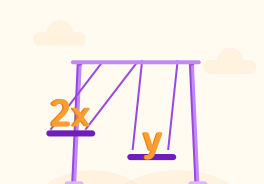YOU ARE LEARNING:
Non-linear Simultaneous Equations

Non-linear Simultaneous Equations
We can find the points of intersection between straight (linear) lines and quadratic lines on a graph.
Sometimes you will be given two equations to solve: one linear and one non-linear (usually a quadratic). You can solve these by eliminating one of the variables from the quadratic and then solving that equation.
We can usually expect there to be 2 points that are common between a linear and a quadratic equation. This is because the quadratic is shaped like a U when drawn on a graph. This may not always be the case, however.
For example, we might be asked to solve y=3x and y=x2+2 simultaneously.
Substitute y=3x into y=x2+2
3x=x2+2
Rearrange 3x=x2+2 to equal 0
x2−3x+2=0
Factorise x2−3x+2=0

The correct factorisation is (x−1)(x−2)
−2−1=−3, and −2×−1=2. Therefore, we can put these factors in brackets with x. We can now treat these as two separate equations.
One solution is x=1. Solve x−2=0

Substitute x=1 into y=3x. What is the value of y?

Substitute x=2 into y=3x
y=3×2 so y=6
That's it!
When x=1,y=3 and when x=2,y=6
This means that the lines would cross at (1,3)and(2,6)
Remember which x goes with which y!
What quadratic equation do you obtain if you eliminate y from: y=4x and y=x2+3? Give your answer in the form y=ax2+bx+c

What two values of x solve x2−4x+3=0?

As x=1 and x=3, what are the solutions to y=4x and y=x2+3?

